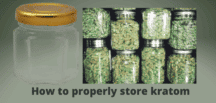As global awareness about the environment increases, many people prefer buying eco-friendly products or at least try to avoid products that are harmful to the environment. If you are someone who does the same and also wants to buy Kratom, you probably are wondering what does Kratom do to the environment.
Well, in this article, we will answer all your concerns. Is Kratom harmful to the environment? Is it something adding to the deforestation happening in Southeast Asia? Or is Kratom have positive effects on the rainforests and overall environment in the region?
Keep reading, and you will have all your answers.
How and Where Is Kratom Grown?
Before we discuss the effects of kratom on the environment, let’s talk about where the Kratom tree is grown. The scientific name given to the Kratom tree is ‘Mitragyna speciosa‘, and it is grown in the Southeast Asian regions of Indonesia, Malaysia, Thailand, etc. Since these are humid areas with nitrogen-rich and fertile soil, they are perfect for the growth of the Kratom tree.
While there are a few Kratom plantations, most of the Kratom is obtained by farmers who go deep into ancient jungles and harvest Kratom from naturally growing Kratom trees. Often they plant Kratom trees inside jungles, and in a few years, these trees produce a high-quality Kratom leaf. This leaf can have different Kratom colors, such as Green Kratom.
How Kratom Is Saving Southeast Asian Environment
Due to the recent surge in Kratom demand, Kratom farming has become much bigger than before. The spread of fake news has made people think that there will be negative effects on the environment; however, they couldn’t be more wrong! When you buy Kratom, you can be sure that you’re helping to save the Southeast Asian environment! This is true for several reasons:
Kratom vs. Palm Oil Plantation:
To understand Kratom’s effects on the environment, you need to know that there are two prime options farmers in Southeast Asia have for farming: Kratom and palm oil. Whereas the region is great for farming, palm oil has catastrophic effects on the environment and quickly eats up the region’s rainforests. It is estimated that the rainforests lost to palm oil farming are equivalent to roughly 300 football fields per day. Crazy, right?
On the other hand, Kratom is considered an understory crop. This means that Kratom trees thrive when they are growing under other larger trees. They require filtered sunlight through the branches of other trees, so deforestation is not a concern for people worried about Kratom’s effects on the environment. Kratom strains such as the popular Maeng Da Kratom could be ruined if exposed to unobstructed sunlight! Read this blog to learn more about the Kratom experience of farmers.
Sustainable and Ethical Practices:
The effects of kratom on the environment are positive because sustainable and ethical practices are employed in Kratom farming. Modern-day farming methods use toxic fertilizers and pesticides which contain various chemicals that are harmful to the environment. These chemicals can get absorbed by the ground-water and spread to nearby trees. In forests, such a thing could become a massive issue as the entire ecosystem has to support itself.
For Kratom farming, no such chemicals are used, and the best Kratom is always 100% pure. When it is time for harvesting Kratom, a selective pruning method is used. Leaves that are ready to be harvested are picked by experienced farmers, and the Kratom tree itself remains intact. After this, Kratom goes through quality-checking processes to remove any contaminants before it is sent to Kratom vendors who provide Kratom for sale in the US.
Kratom Protects Wild-Life In Southeast Asia:
One of our personal favorite Kratom’s effects on the environment is regarding wildlife in Southeast Asia. When farmers in Southeast Asia choose Kratom instead of palm oil, they prevent deforestation from happening, which saves the rainforests. These rainforests are home to several rare species of animals, such as the endangered Sumatra Tiger (only 700 remaining in the world) or the Orangutan. Through Kratom farming, the wildlife habitats of species such as the Sumatra Tiger and the Orangutan can remain preserved for centuries to come.
Kratom and its Role in Southeast Asia
Kratom is native to Southeast Asia. It is a tropical plant that needs hot and humid conditions, along with nutrient-rich soil, factors that are unique to Southeast Asia.
As part of native culture for centuries, Kratom has had a deep impact on the lives of millions in the region, especially people living in rural areas or near forests. As Kratom is getting more and more popular in the West, there is also a rise in the cultivation of Kratom trees in the region.
Now known as the money tree in rural areas, Kratom has a pleasant effect on local farmers and the local economy when it comes to money. As the demand in the West, especially in the US rises, more and more money is flowing back to local farmers.
According to some estimates, there are more than five million Kratom enthusiasts in the US, with the US importing a great worth of yearly Kratom now. The most popular products are Kratom powder and Kratom capsules. The rise in demand is making more and more farmers, especially in Indonesia, switch to Kratom cultivation instead of palm oil.
So, what is the effect of kratom on the environment? Is more Kratom plantation good or bad news for the environment and the forests?
What Does Kratom Do to the Environment?
Let us share some facts about the Southeast Asian biodiversity, environment, rainforests, and global impact.
To start with, tropical forests are important for sustainable life on earth, no matter where you live. Interestingly, the dense rainforests in Southeast Asia make up 15% of the total rainforests in the world, even when the region makes up 7% of the world in terms of area.
On top of that, the region stocks more than 65% of global carbon and hosts almost 65% of the floral and faunal diversity in the world.
The point is, a positive or negative impact on the Southeast Asian environment has both short and long terms effects all over the globe.
Here is the bad news. Countries like Malaysia and Indonesia are also major exporters of palm oil. With 44% of the total global exports, Indonesia tops the table while Malaysia ranks second. Both countries earn almost $20 billion from palm oil exports.
However, palm oil cultivation has an adverse effect on the local environment. Millions of hectares of forest were destroyed to make room for palm oil plantations. Fortunately, Kratom has a major impact on reversing the trend.
The first answer to the question of what is the effect of kratom on the environment is reversing the effects of deforestation. You must be wondering, how does Kratom do that?
Kratom Effects on Forests
Kratom grows naturally in Southeast Asia and makes a natural part of local rainforests and jungles. This means when farmers grow Kratom trees, they are adding to the local forest area.
Second, unlike palm oil, which requires farmers to cut other trees and forests to make space for palm oil cultivation, Kratom works just fine under other larger trees. As most Kratom strains come from Indonesia, and it makes almost 95% of the total Kratom exports to the world, Kratom plantation has a major effect on both environment and the local economy.
Kratom tree grows naturally, so farmers don’t need artificial fertilizers and chemical sprays, which is the case with palm oil. In addition, Kratom is an average-sized tree with deep roots, while palm oil plants have shallow roots.
This means Kratom trees create a natural shield against soil erosion and flooding. Kratom also contributes to saving the natural habitat of local species, many of which are now at the risk of extinction.
All in all, Kratom’s major effect is the positive impact on deforestation, as it helps add to the forest footprint.
Final Words
We are sure, you now know the answer to what is the effect of kratom on the local environment in Indonesia. When you are buying Kratom in the US from reputable brands like Buy Kratom Bulk USA, you are not only helping millions of local farmers back in Southeast Asia but also contributing to the positive impact on the environment. Visit our Kratom blog to learn more about Kratom.



